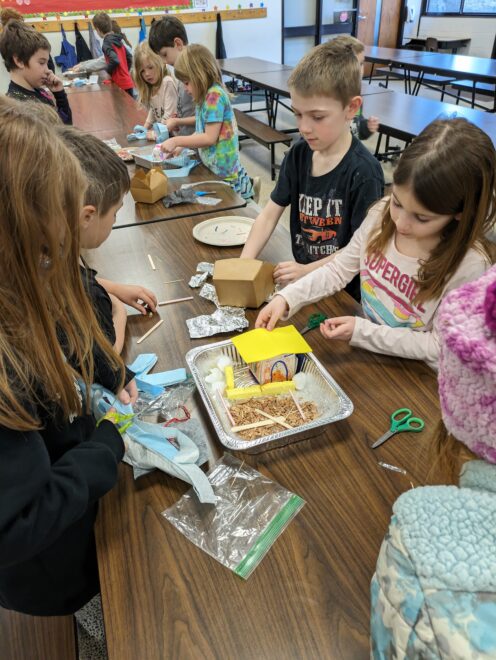At Inland Seas Education Association (ISEA), we’re well-known for our Schoolship, ROV Engineer and Explore, and Watershed Exploration programs. However, this past winter, we partnered with SEEDS Eco-Schools, an after-school program that connects students with their local environment, on a lesser-known project. SEEDS programs offer a range of benefits for children, including structured playtime, nutritious meals, hands-on activities, and peer socialization.
Learning by Doing: The Flood Barrier Challenge
Through a two-part program, ISEA staff members visited 12 SEEDS sites across northwest Michigan throughout the winter.
Following an introduction to floods and their causes, students in Session 1 explored the topic through discussions and questions. Age-appropriate discussions were also held on flood severity, the occurrence of 50- and 100-year floods, and their connection to climate change. The session concluded with the introduction of the challenge: students would build flood barriers using manmade, natural, or a combination of both materials, to protect a model dog house. Discussions included different types of manmade and natural barriers, such as storm drains and the water-absorbing properties of moss.

In Session 2, having learned about floods and different barrier types, students built their flood barriers to protect a decorated paper dog house. They used a variety of materials like clay, moss, popsicle sticks, and sponges. Working in groups, they engineered what they hoped would be the perfect flood barrier. After construction, a simulated flood was created by pouring water into an aluminum pan used as a workspace. Students quickly observed whether their barriers held or if their model dog houses were washed away.
Beyond Success or Failure: Valuable Lessons Learned
The true value of these programs lies not just in successfully completing the challenge, but in the learning process. Students often learn more from failures than successes. Through experimentation, they discovered which methods worked and didn’t work, allowing for knowledge sharing and rapid design improvement.
The project also highlighted the effectiveness of combining natural and manmade flood barriers, mimicking nature, biomickery, in infrastructure design. Discussions explored how good flood management contributes to a healthier Great Lakes by preventing pollutants, such as pesticides, oils, and heavy metals, from entering floodwater runoff. Additionally, instructors emphasized the vital role of wetlands in absorbing water and pollution, highlighting their superiority over manmade infrastructure like parking lots in this function. The importance of clean water sources for a healthy Great Lakes was also addressed.
Final Takeaways
One of the most inspiring aspects of these programs was the supportive environment among students, particularly during the experiment phase. Regardless of success, students cheered each other on, fostering connections and a practical understanding of how we impact our local environment – critical aspects in building long-term health for our Great Lakes.
The blog post Building Flood Resilience was written by ISEA Marketing and Communications Coordinator Harrison Fischer and is based off of an interview provided by ISEA Great Lakes Educator Liam Fries. If you would like to write a blog post about your experience with Inland Seas or the Great Lakes please contact Harrison Fischer at hfischer@schoolship.org.